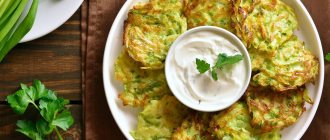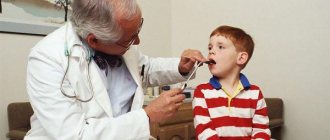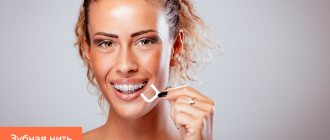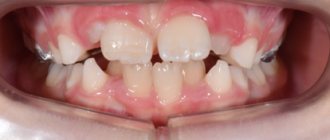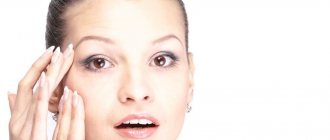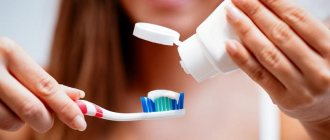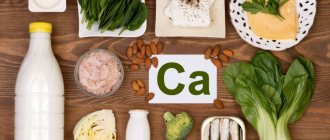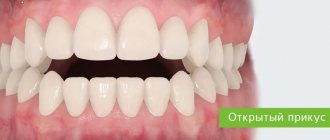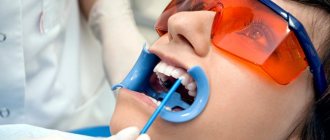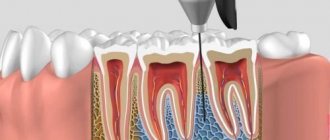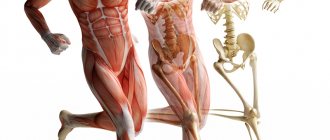These systems are the most effective for correcting malocclusions, etc. However, eating with braces is significantly complicated for a number of reasons. After installing the system, the orthodontist must advise the patient on how to eat with braces, which foods can be eaten and which cannot, etc.
Braces are becoming a big problem for children and their parents. It is difficult to explain to a child why this or that product should not be consumed, so adults should first of all understand this issue, and then convey this information to the child.
Food during the first days of installation
Installing braces requires following a strict diet. In the first days after its installation, the body adapts, during which a person most often experiences discomfort and pain caused by pressure on the teeth and gums. In this regard, the patient may have the feeling that the teeth are loose while eating. This may last 2-3 days.
Eating rough food becomes impossible. The most difficult adaptation period is observed in those who wear systems on both jaws.
The diet in the first days after installation includes foods only with a liquid or soft consistency:
- bouillon;
- cream soup;
- yogurt;
- smoothie;
- milk-based cocktail;
- gruel;
- curd;
- jelly;
- juice;
- fruit drink, etc.
Doctors recommend consuming baby food during this period, as it contains many vitamins and nutrients. The product saturates the body with all useful microelements, and its consistency is not capable of injuring the gums or causing damage to the structure.
In addition, the period after tightening the ligatures or replacing the arches is considered an adaptation period. During it, you also need to eat only liquid and semi-liquid food.
Nutrition with braces should also be based on your own feelings. If a particular food causes discomfort when consumed, then it is better to refuse it.
What experiments are acceptable during correction?
Food, of course, should not only be gentle, but also beneficial for your entire body. Therefore, even from unwanted products you can and should prepare your favorite dishes. You just have to take into account that you will have them in the device.
- hard vegetables with braces No, but they will become soft after cooking - for example, by steaming, after which they can easily be eaten as a salad.
- Do you like sandwiches and burritos? If the composition contains crispy vegetables and meat, cut them into portions using a knife and fork.
- Is it possible to eat sushi with braces ? You shouldn’t put one whole portion into your mouth, as with locks on your teeth you might choke. Your favorite taste will not change because sushi and rolls are cut into pieces that you can chew thoroughly.
- Avoid biting into whole stone fruits such as apricots, peaches, apples and pears. Cut them into pieces to reduce the likelihood of damage to the lock or orthodontic arch.
- Can I eat corn after getting braces? Cheers! But only the grains must first be cut from the cob.
What not to eat with braces
There are a number of strict restrictions on what you cannot eat while wearing braces. First of all, you should completely avoid solid food. Any hard food can lead to breakage of system arches and other elements, after which the load on the jaw and teeth changes. This leads to spontaneous displacement of the molars. Unsuitable products can increase the load on the dentition, increase pain, provoke caries and inflammation in the gums, damage structural parts and detach them from the enamel surface.
In addition, it is necessary to ensure that the food is at the optimal temperature: not cold or hot.
When wearing braces, you should pay attention that you should not eat foods that contain sticky or coloring components.
Solid foods
While wearing this system, you will have to completely avoid the following products:
- seeds;
- drying;
- nuts;
- crackers;
- snacks;
- chips;
- dried fruits;
- bread and baked goods with crispy crust;
- hard fruits and vegetables (they can only be consumed in processed form);
- corn (cobs);
- tough and fibrous meat;
- lollipops;
- caramel;
- ice cream and popsicles, etc.
Coloring agents in products
You should avoid eating products that contain natural pigments or artificial coloring agents. They can stain enamel and braces (especially plastic structures). There are pores on the plastic into which the coloring pigment can easily enter. This leads to a change in the color of the product and loss of its original appearance. But this is not the only limitation. You should be careful if you wear the following designs:
- sapphire braces;
- ceramic braces;
- rubber braces.
All of these species can gradually change their color.
It is not recommended to eat:
- Red wines.
- Juices of rich and bright colors.
- Drinks with colors (with and without carbonation).
- Black tea.
- Strongly brewed coffee without cream.
- Vegetables (beets and tomatoes).
- Berries (strawberries, raspberries, blackberries, blueberries and blueberries).
- Paprika.
Permitted products when wearing the design
Wearing braces does not mean that you have to follow a very strict diet. Your diet may not be meager and extremely close to what you are used to, except that you need to avoid products that are dangerous to the system. Otherwise, the list of healthy foods is large:
- cream soups;
Cream soup of baked pumpkin and potatoes with melted cheese
- steamed dishes;
- puree;
- eggs;
- soft fish/meat cutlets;
- boiled potatoes;
- porridge;
- baked goods (soft only);
- canned fish;
- fermented milk products;
- caviar (squash/eggplant);
- soft fruits/vegetables;
- smoothie;
- milkshakes.
Tricolor milkshake
Other restrictions when correcting bites
The list of prohibited products can be supplemented with the following items:
- Chocolate with nuts. This dessert is prohibited for several reasons. Nuts can injure tooth enamel or lead to breakage and unsticking of braces, and chocolate tends to stick to teeth and parts of the system, after which it is quite difficult to remove it from there.
- Any carbonated drinks. Due to increased acidity, they negatively affect the condition of the enamel (they can stain or discolor it). This leads to stains being found on the teeth after the braces are removed.
- Small-grained berries (raspberries, strawberries, etc.). Their small bones get stuck in the structural elements, which can damage it and ruin its appearance. Removing them from there is also difficult.
- Popcorn, because it may contain hard corn kernels.
Is it possible to eat chocolate while wearing braces?
It is advisable to completely exclude any chocolate from the diet, because it negatively affects the braces system. Dark chocolate may stain the structure. In addition, it is a hard product and, when bitten, can cause a number of negative consequences. As it melts in the oral cavity, it becomes viscous and sticks to tooth enamel and structural elements. The nuts and dried fruits it contains can cause the braces to break and come off.
Sticky food
It is strictly prohibited to eat sticky or viscous food while wearing the system. The reason for this is the adhesion of such substances to the brackets, arches and ligature. It will be quite difficult to remove it from there, and the remaining particles can trigger the process of oxidation and corrosion, which will lead to caries, inflammation in the gums and breakage of braces.
To avoid such disastrous consequences, you should exclude from your diet:
- corn flakes and sticks;
- cheese, especially processed cheese;
- soft bakery products;
- nougat;
- caramel;
- marshmallow;
- marmalade;
- toffee;
- chips;
- dried fruits.
Such products stick to the power arc, changing its position. Among other things, they can damage locks and ligatures. In this case, you will have to change the system to a new one.
In addition, these products can harm tooth enamel. They accumulate under the braces in hard-to-reach places. This leads to further proliferation of pathogenic microflora in the oral cavity. As a result, plaque forms on the teeth, caries appears, gums become inflamed, and tooth enamel is destroyed.
Thus, to eliminate the negative consequences, it will be necessary to suspend treatment, which will reduce its effectiveness.
If sticky food does get on the structure, you need to urgently clean all places where it accumulates using:
- toothbrush;
- special brush;
- floss;
- irrigator.
Chewing gum is specifically prohibited. If the bracket system gets stuck, it will have to be removed in the clinic using special devices and chemicals. You won't be able to do this on your own.
Eating right during the adaptation period
During the first few days the person experiences pain. It may be unusual for him to feel the braces on his teeth, and when chewing, it may seem as if his teeth are moving with his jaw.
Table No1. Effective ways to relieve pain.
| Way | Short description |
| Saline rinse | The simplest way to eliminate inflammatory processes in the mouth. You need to stir 1 teaspoon of salt in 200 ml of warm water until it is completely dissolved, and rinse your mouth with the prepared solution when necessary. It is important that the water is not too hot. |
| Use orthodontic wax | To prevent sharp parts of the structure from causing pain, use orthodontic wax (must be provided by a dentist, but in extreme cases, it is also sold in pharmacies). If the wax falls off the arches, have the doctor cover them with heated gutte-percha (it hardens in about 40 seconds, but lasts longer than the wax). |
| Taking painkillers | If the pain is severe, you can take a pain reliever, such as Ibuprofen, which is available over the counter. If we are talking about a child/teenager, then you should not give him Aspirin, since this drug increases the risk of hepatocerebral syndrome. |
On a note! The adaptation period can last from 2-3 to 7 days. At this time, it is especially important to follow a diet due to the increased risks of complications.
What foods are you not allowed to eat? First of all, these are all solid foods (they provoke too much pressure), popcorn, seeds, chocolates with additives, as well as sticky/stretchy foods.
Prohibited foods include all solid foods
Here is a sample menu for the first week of wearing:
- Braces for children
- jelly, cottage cheese, sour cream;
- soups, broths;
- purees (meat/vegetable/fruit);
- smoothie;
- cutlets from vegetables, meat (necessarily soft);
- soft fruits;
- all types of cereals.
Vegetable puree
Eating these products will not harm, but the body will be provided with the necessary amount of calories. By following a diet, you will quickly adapt to wearing the structure, after which your diet can be expanded.
What not to do with braces
When wearing braces on your teeth, you will have to get rid of some bad habits, which include:
- chewing the tip of a pen or pencil;
- nail biting;
- drinking alcohol, etc.
When installing a system, many people wonder why they should not drink alcohol. The reason for this is their high content of sugars and other substances that have a bad effect on the enamel, forming a hard coating on it. When they settle on its surface, they cause caries and discoloration of the enamel. In addition, particles deposited on the structure can lead to gradual deformation and a change in its shade.
Alcoholic drinks are also dangerous because they dry out the oral cavity, making it vulnerable to various negative factors. Thus, structural elements can injure the gums, enamel and oral mucosa.
Aligners: what about them?
Aligners have no activation as such. The beginning of treatment is the first mouthguard, which must be worn almost constantly, 22 hours a day. On the first day after putting it on, adaptation will begin.
Aligners also cause pain as teeth begin to move. But their effect is softer than that of braces. In addition, the aligners do not cause irritation, since they do not have metal protruding parts (braces, arches). Therefore, adaptation occurs faster.
The aligners are removed for meals. Therefore, there are no restrictions on food at all - everything is determined solely by the patient’s feelings. If chewing is difficult, you can temporarily switch to softer foods. If there is no pain, you can eat everything.
After eating and before putting on the aligners, you should definitely brush your teeth. If this is not possible, it is better to avoid foods that can get stuck in your teeth. Then rinsing with the elixir will be enough.
Fewer restrictions is one of the benefits of aligners. Compared to braces, they require much less attention in everyday life, and it is easier to survive 10-12 months of treatment.
Optimal food temperature
The temperature of the food consumed is important. It must be strictly controlled to avoid negative consequences.
Food should not be cold or hot. Sudden temperature changes are especially dangerous because they lead to microcracks in tooth enamel. In addition, the structure can be cooled or heated, while maintaining the temperature for a long time. In this case, it is a catalyst for harmful effects.
Food of low or high temperature negatively affects the glue that fixes the system on the surface of the teeth. So it can come off easily.
When alternating contrasting temperatures (washing down ice cream with hot coffee), the design may change its color when interacting with heat-sensitive components. This not only affects its appearance, but can also lead to the destruction and replacement of the system.
Orthodontists and dentists recommend adhering to the following rules:
- Do not eat foods that are scalding hot. It should be as comfortable as possible for the oral cavity and tooth enamel, and not cause discomfort.
- Frozen fruits and berries are not recommended to be consumed immediately. You should wait until they defrost and reach a comfortable temperature.
- Eating ice cream is acceptable, but should be done as little as possible. Some experts believe that you should not eat ice cream while wearing braces, but this is not true. It is recommended to eat it with a spoon, separating small pieces. They must be placed just outside the dentition. It is highly undesirable to bite off whole pieces of ice cream with your teeth.
Getting used to braces
The hardest part will be getting used to braces. You will feel discomfort and pressure on your jaw. How long this will last depends on your sensitivity. Typically, getting used to braces takes from 3 days to 2 weeks.
- Please be patient
. One day you will get used to the braces and they will stop bothering you. It will become easier to eat, speak and brush your teeth. - If the structure cuts the inside of the cheeks
, you can cover it with special wax or silicone. - diction problems
appear , then do not worry - when you get used to it, you will begin to speak as before.
If you feel severe pain or it seems to you that some part of the structure is seriously injuring the mucous membrane, call the orthodontist. It will adjust the system, and the addiction will be easier.
You will also have to get used to braces psychologically. Don't be shy. Many people now have orthodontic systems installed. You can meet them in everyday life and among celebrities.
To prevent the period of adaptation and wearing the system from causing severe inconvenience, adhere to the recommended diet and properly care for the oral cavity and structures.
Recommendations for cleaning braces
The braces system requires daily care and cleaning. To do this you need to purchase the following devices:
- V-shaped brush.
- Cleaners.
- Super floss.
- Irrigator.
- Mouth rinses.
- Orthodontic wax (for application to individual structural elements to avoid damage to the mucous membranes).
Cleaning the mouth should be done no later than 10 minutes after eating. Each tooth should be brushed for at least 10 seconds, paying attention to each bracket and archwire. During the procedure, you need to rinse your mouth frequently to remove food from hard-to-reach places.
The final step is to clean the spaces between your teeth using dental floss and then rinse again.
Caring for braces after meals
If before braces you were able to get by with just chewing gum after meals, then with the installation of the system you will have to acquire a whole arsenal of care devices and include an additional 15 minutes in your lunch plan for dental care.
The ideal algorithm for brushing teeth with braces after eating looks like this:
- Cleaning your teeth with a special brush for braces with a recess for a row of clasps. Additionally, you can thoroughly clean the space around each bracket with a mono-beam brush.
- Cleaning hard-to-reach areas between the clasps and under the archwire using orthodontic brushes.
- Cleaning dental spaces with superfloss.
- Mouth rinse.
- Attaching elastic bands (if you wear them)
But if you don’t have time to do all this after every meal, then don’t forget about mouthwash and dental brushes to get rid of noticeable food residues under braces.
What can be included in the menu
Nutrition while wearing braces should be carefully thought out. Below is a list of products that are allowed to be included in the diet:
- porridge;
- puree soups;
- canned fish;
- Cod liver;
- vegetable caviar;
- soft cutlets, meatballs;
- fruit and vegetable smoothies;
- milk-based cocktails;
- soup with meatballs or finely chopped meat;
- yogurt;
- jelly;
- cottage cheese;
- soft fruits.
Knowing what you can eat while wearing braces, you will be able to avoid many problems, and the system will last the entire prescribed period.
Sample menu for the day
A properly selected diet will provide the body with minerals and vitamins to support healthy teeth.
Breakfast
- smoothies with the addition of any vegetables and herbs;
- fried eggs;
- well-cooked porridge, preferably passed through a blender;
- fruits;
- nut urbechi (without pieces), vegetable spreads;
- soft bread, preferably without crust;
- yogurt;
- cottage cheese.
Dinner
If you have to dine outside the home and need to take food with you, then the following are suitable:
- sandwiches made of soft bread with vegetable pastes, soft sausage or cheese, tuna;
- baby food in jars;
- boiled chicken, boneless;
- puddings;
- jelly;
- bananas and other fruits, if possible, cut them.
Dinner
- puree soup, any;
- mashed potatoes;
- steamed vegetables;
- paste;
- casseroles, meat, vegetable;
- beans;
- rice.
You can eat soft muffins, cookies, and sometimes chocolate (without fillers) with braces. Use them as a reward for following your braces diet.
In any case, braces mean discomfort when eating. Do you really need braces as your doctor advises?
Are you ready to carry this pile of iron in the form of metal and ceramic braces in your mouth for the entire duration of treatment (a year or two)?
Rub your tongue against them, polish them until they shine, eliminating pieces of food? Braces when eating are uncomfortable and not aesthetically pleasing. Consider treatment with aligners. There will be no problems at all when eating - food will not get stuck in them and your breath will not smell bad. The Star Smile company operates in more than 70 cities of Russia and will be able to offer you competent consultation with an orthodontist in your city. And the prices will pleasantly surprise you, because Star Smile has the lowest prices with excellent quality of treatment. Take the first step towards comfortable treatment.
In any case, braces mean discomfort when eating. Do you really need braces as your doctor advises?
I want to know more about aligners!
Orthodontist, candidate of medical sciences Tatyana Vladimirovna Gevorkyan comments:
— By the way, some patients (but more often female patients) are even enthusiastic about the idea that they will eat less and, as a result, lose weight.
Losing weight with braces? - original thought)
- True, this inspiration for the desire to lose weight, limiting one’s diet while wearing braces, does not always last for the entire course of treatment, but that’s another topic. In fact, braces do impose some restrictions, but not so strict and cruel.
And these restrictions apply not so much to food products, but to the process of eating. When undergoing orthodontic treatment with braces, orthodontists recommend grinding food, but not turning it into a homogeneous slurry. You can chop food with a fork and knife so that a person does not make biting movements.
Yes, those who like to bite crispy green apples will have to get used to the knife, so as not to accidentally peel off the bracket when biting. The same goes for tough meat or other tough foods. Only nuts, crackers, and toffees (popularly called “sealers”) are strictly prohibited when eating while wearing braces. But it’s unlikely that we all have a serious habit of consuming these products every day. Therefore, real gourmets should not fall into a trance at the thought that there is little they can afford to eat with braces.
General rules for eating during treatment
- 1. Pay attention to food temperatures . This is especially true for the high-tech Damon system, because... its arch tends to “weaken” when eating cold food and stops movement in the oral cavity. And it “activates” already during normal temperature. A small life hack from our orthodontist Alena Avernina - if you want to reduce “pain” for a while in the first days - we recommend that you take a small portion of cool food.
- 2. Skip the toothpicks. Inadvertently, you can tear a bracket out of place or damage the archwire.
- 3. Grind food, especially hard fruits . Cut the meat into small pieces, or chop the apple in a blender. This will significantly reduce the risk of system damage.
- 4. We recommend reducing the amount of sugar and acidic foods you consume . Such products lead to erosion of the enamel, which is already subject to heavy stress throughout the entire process of correcting your bite.
Hot and cold food
Even people with absolutely healthy teeth should not expose their teeth to sudden temperature changes. And if a person wears braces, eating too hot and cold food is completely prohibited. This is especially true for bracket systems, which contain thermoactive elements that can change their properties under the influence of temperature.
You should avoid the following foods:
- cold ice cream and desserts;
- hot soup;
- scalding coffee, tea and other drinks.
